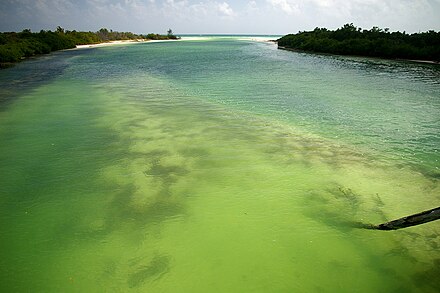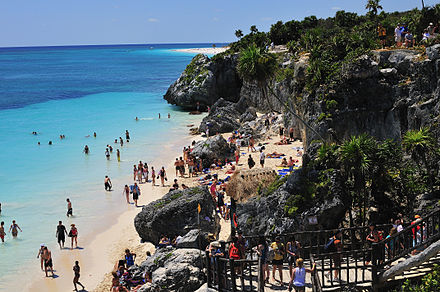Quintana Roo - state of Mexico
Quintana Roo, also called the Mexican Caribbean is a state of Mexico that is part of the Yucatán Peninsula. Its shoreline along the Caribbean has grown in just a few decades into a major tourism destination. It includes large resort cities built for the Yanqui/Euro tropical vacation business, small communities with a more local Maya-Mexicano character, and fascinating ancient Maya archaeological sites.

Regions
The Mexican Caribbean is divided in some micro-tourist destinations that are: Cancún, the Riviera Maya, the Maya Zone and the Great Costa Maya.
The Riviera Maya is a tourist corridor that goes from Puerto Morelos until Tulum. The Riviera Maya´s heart is Playa del Carmen, an eclectic and seductive city that mixes the Mexican flair with a Caribbean ambiance influenced for all possible cultures from all over the world.
The Maya Zone includes some small towns and the Great Costa Maya is formed by Chetumal (capital of the state), Bacalar and Mahahual.
Cities
- Chetumal 📍 — hosts the Museum of Mayan Culture, and has several archeological sites nearby
- Akumal 📍 — a small town with a spectacular bay, clear waters and underground rivers
- Bacalar 📍 — an historic town with the beautiful lagoon of 7 colors
- Cancún 📍 — beach tourism central
- Mahahual 📍 (Majahual) — the next Playa del Carmen, a tourist development
- Playa del Carmen 📍 — an eclectic and seductive Mexican city
- Puerto Aventuras 📍 — a secluded, charming district
- Puerto Morelos 📍 — a quiet fishing town
- Xcalak 📍 — a remote village for great fishing and diving
Other destinations

- Cobá 📍 – large ruined Maya city near Tulum
- Felipe Carrillo Puerto 📍 – historic 19th century Maya town
- Sian Ka'an 📍 – a UNESCO World Heritage listed biosphere reserve
- Tulum 📍 – impressive Maya archaeological site built in a cliff that faces the ocean
Islands
- Isla Contoy 📍 – an uninhabited small island and bird sanctuary
- Isla Cozumel 📍 – the largest island and port of call
- Isla Holbox 📍 – a tropical paradise out of hustle and bustle
- Isla Mujeres 📍 – small cozy retreat close to Cancún
Understand
This eastern part of the Yucatán Peninsula shares much history with the neighboring states of Yucatán and Campeche; a long Maya heritage and conquest by the Spanish in the 1500s. It was long part of the state of Yucatán. In the 1840s, however, local Maya people revolted against the Hispanic people who dominated politically and economically, starting what is called "the War of the Castes". With long battles the Maya succeeded in driving out the non-Maya from this area, and established their own government with the capital in Chan Santa Cruz, now the town of Felipe Carrillo Puerto -- the Maya state was briefly recognized as an independent nation by the British Empire. An uneasy truce ended in the 1890s with a Mexican counter attack which succeeded in bring the area back under the Mexican flag in 1901. The area was then designated the Mexican Territory of Quintana Roo, named after Andrés Quintana Roo, a Yucatecan hero of the Mexican war of Independence in the early 19th century.
Comparatively sparsely populated and undeveloped, the territory of Quintana Roo did not achieve statehood until 1974, making it Mexico's youngest state. In the 1970s, Mexican developers realized the area's beautiful beaches, lush forests, and historic Maya ruins could make it a prime visitor destination if only infrastructure could be put in place. New highways were laid, new International Airports constructed at Cozumel and Cancun, and hotels were built. The tiny remote village of Cancun became a boom town, the first center of the new development of Quintana Roo, drawing a new population of workers and residents from other parts of Mexico.
Today Quintana Roo is popular with visitors with bustling tourism developments thriving while large areas of natural beauty remain unspoiled.
Get in
Highways link Quintana Roo to Yucatán.
Major international airports are at Cancun (IATA: CUN) and Cozumel (IATA: CZM). Regional airports include Chetumal Airport (IATA: CTM)
Get around
Quintana Roo, and Mexico in general has an excellent bus system. ADO (Autobuses del Oriente) provides first class bus service between major cities, sights and the airport. It is wise to use their app for buying and storing tickets, as you do not have to deal with buying them in person - when buying the ticket online, just show the QR from the app to the bus driver.
See
Do

- Aventuras Mayas - Offers jungle and ocean adventures, including zip lines, rappeling, snorkeling in tropical reefs and underground rivers, as well as visits to the archeological site of Tulum
- Garrafon. Garrafon Natural Reef Park is on charming Isla Mujeres, which is beautiful both in and out of the water. 35-minute cruise from Cancun.
- Swim with Dolphins - Swim with dolphins and enjoy this unforgettable and magic experience. Swimming with dolphins is everything you´ve imagined and more - and a chance to encounter these highly intelligent and friendly marine mammals which will fascinate and amaze you.
- Jeep Adventures. Your self-drive Jeep Adventure will take you on an amazing journey around Cancun and the surrounding areas and give you the chance to see parts of Mexico you wouldn't be able to see on your own. During your Jeep Adventure you will get to: Explore Mayan Ruins, visit a private jungle reserve, swim/snorkel in an underground cenote, experience an amazing interactive zoo, visit an authentic Mexican town, enjoy a buffet lunch on the beach, and many other activities all while under the guidance of a friendly, knowledgeable and humorous guide.
- Aqua Tours. Exciting water tour! Choose either a Jetski or two person Jetboat for a trip through the lagoon out to snorkel on the reef, their top tours are Jungle Tour and the Sailing Quest (Catamarans).
- The scuba diving and snorkeling around Isla Mujeres is unforgettable. The Manchones Reef begins just off of Isla's shore and the Cuevones and Banderas Reefs are close by. The waters are calm and clear - perfect for the beginner as well as the advanced diver.
- Lobster Dinner Cruise. Romantic night out. Both the guys and gals will enjoy this trip. Take a trip out on the calm lagoon on a beautiful boat with friends you have not met yet. The staff allow you to take part in the fun or settle back and watch the sunset. Steak and lobster is cooked on the boat and tastes so much better away from the city sounds
- Cenotes of the Yucatán
Eat

- Owing to the closeness to the Caribbean you can get a lot of seafood here
- Generally speaking most hotels and restaurants in places a tourist might conceivably pass through serve "internationalized" fare as well as more local food.
Drink
Stay safe
